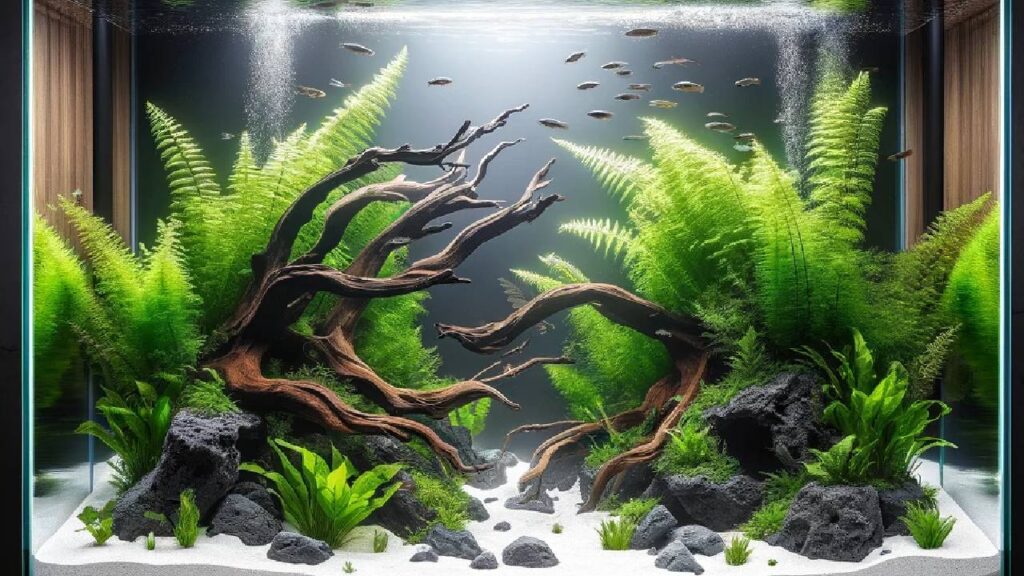When pondering the question, “What is Java Fern?” one opens the door to a whole world of exciting aquatic scenarios and possibilities. The popular aquarium plant is renowned for its resilience and aesthetic appeal, Java Fern (Microsorum pteropus) has established itself as a cornerstone in the aquascaping community and is easily one of the best aquarium plants for beginners.
In this comprehensive guide, we will delve into the essence of Java Fern, exploring its identity, suitability for beginners, and ease of cultivation. Whether you’re an aquarist novice or a seasoned enthusiast, understanding the nuances of this remarkable plant will enhance both the health of your aquatic ecosystem and its visual allure.
What is Java Fern?
Java Fern, a native of Southeast Asia, thrives in a variety of water conditions, making it a versatile addition to almost any freshwater aquarium. It’s a hardy plant that grows on rocks, wood, and other hard surfaces, rather than rooting in the substrate. This unique trait stems from its epiphytic nature – a term used to describe plants that grow on other objects for support, rather than drawing nutrients from the soil.
The leaves of Java Fern are its most striking feature. They range from bright to dark green, are typically long and lance-shaped, and can grow up to 12 inches (30 cm) in length. These leaves create an enchanting, forest-like canopy within the aquarium, offering shelter and security to shy fish and invertebrates. Furthermore, Java Fern is known for its slow growth rate, which, while requiring patience, makes it manageable and less demanding in terms of maintenance.
Java Fern reproduces through a fascinating process. Tiny plantlets form on the older leaves, eventually growing their own roots and leaves. Once mature, these plantlets can be detached and attached to new surfaces, propagating the plant and enabling aquarists to expand their underwater gardens.
Is Java Fern Good for a Beginner?
Absolutely! Java Fern is an excellent choice for beginners in the aquarium hobby. Its resilience to a range of water parameters – including pH, temperature, and light levels – makes it a forgiving plant for those still mastering the art of aquarium maintenance. Its ability to thrive in low-light conditions is particularly advantageous for novices who may not yet have invested in high-end lighting systems.
Moreover, Java Fern’s epiphytic nature simplifies planting. Beginners can easily attach it to driftwood or rocks using string or fishing line until the plant’s roots naturally adhere to the surface. This method eliminates the common beginner struggle with planting and uprooting in substrate, thus reducing the chances of disturbing the aquarium’s ecosystem.
Is Java Fern Easy to Grow?
Java Fern’s ease of growth is one of its most appealing characteristics. It requires minimal care, making it an excellent choice for both novice and busy aquarists. The plant is adaptable to a wide range of water conditions, thriving in pH levels from 6 to 7.5 and temperatures between 68°F and 82°F (20°C to 28°C). While Java Fern benefits from moderate lighting, it can survive in low-light conditions, although growth may be slower.
Fertilization is not a necessity for Java Fern, but it can benefit from occasional doses of aquarium-safe plant food, especially in tanks with minimal fish waste to provide natural nutrients. It’s also relatively unaffected by common aquatic plant pests and diseases, contributing to its ease of care.
In conclusion, Java Fern is a hardy, adaptable, and visually stunning plant that is well-suited to a range of aquarium setups. Its simplicity in care makes it ideal for beginners, while its unique growth and propagation methods offer interest and variety for more experienced aquarists. Embracing Java Fern in your aquarium not only enriches the habitat for your aquatic inhabitants but also adds a touch of natural elegance to your aquatic display.
